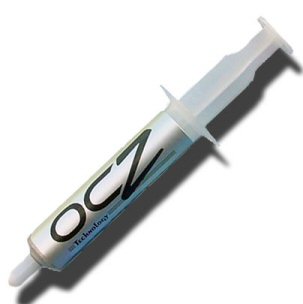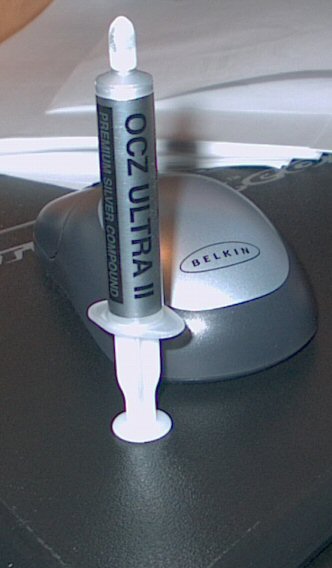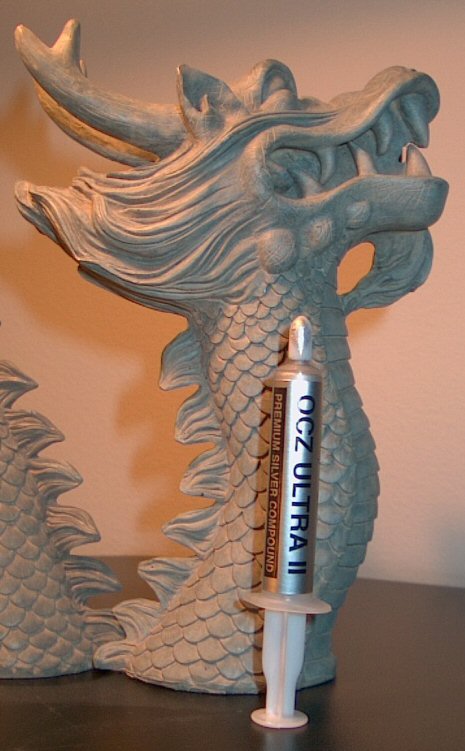Arctic Silver is the gold standard of thermal compounds. Can OCZ’s Ultra 2 dethrone it?
Introduction
Anybody building a PC or swapping components knows that thermal compound is a must for metal-to-metal contact. Its purpose is to provide a medium for thermal transfer between a heatsink and a metal surface such as a GPU or CPU. Without thermal compound, the heat cannot be wicked from the source, resulting in high temperatures that can affect system stability or even cause component failure.
So you know you need it, but are you convinced you need a quality thermal compound? For many of us, the gold standard of thermal compounds is Arctic Silver’s product line. OCZ Technology, maker of performance memory modules and heatsinks, wants to dethrone Arctic Silver with their new OCZ Ultra 2 Thermal Compound. They sent us two syringes of their compound and we compared it to Arctic Silver 3 and generic goo available from CompUSA.
Specifications
- 3 gram syringe
- Thermal conductivity: 8.0 W/mK
- Thermal Resistance:>.06 C-in/W
- Made with 99.9% pure micronized silver
- Not electrically conductive
From OCZ:
OCZ Ultra 2 is a high-quality polysynthetic thermal compound designed to provide maximum thermal transfer between the CPU surface and the heatsink. OCZ Ultra 2 uses a blend of polysynthetic oils that ensure that the compound will not solidify or lose its thermal transfer properties over time. Ultra 2 thermal compound is not electrically conductive, meaning that it is completely safe for use on any surface that requires maximum thermal transfer. Each 3 gram syringe contains enough OCZ Ultra 2 to properly cool twenty to thirty CPUs, depending on the surface area.
Testing
Bryan’s Test Platform
- EpoX 8RDA+ (nForce2) motherboard
- AMD Athlon XP 1800+ CPU
- OCZ Gladiator 2 heatsink
Neal’s Test Platform
- Biostar M7NCG Motherboard
- AMD Athlon XP 1900+
- CoolerMaster HSC-V62 heatsink
Bryan’s Testing & Impressions
When I reviewed the Gladiator 2 HSF, I used Arctic Silver 3 as the thermal compound. The thermal compound was applied using the instructions supplied by Arctic Silver. For the HSF review I used a CompuNurse thermistor and Motherboard Monitor to measure the performance of the Gladiator 2. For this test, I only used Motherboard Monitor since its results were consistent in the HSF review. Unstressed temperatures were measured using a closed case that had been left unattended for at least one hour. The only power management feature enabled was monitor shutdown; all drives remained active. Stressed temperatures were measured by running CPU Stability Test (Google it, multiple download sites) for one hour and noting the temperature at the end of the test.
The Arctic Silver was removed per their instructions and the OCZ Ultra 2 was applied using the same (OCZ did not supply instructions with the review sample). The OCZ compound applied as easily as the Arctic Silver; both were quite easy to spread in an even, thin layer. My test results were:
|
Idle
|
Stressed
|
|
| Arctic Silver |
53ºC
|
60ºC
|
| OCZ Ultra 2 |
53ºC
|
57ºC
|
In my test, OCZ Ultra 2 was able to outperform Arctic Silver while under stress. Environmental conditions were very similar and the CPU load was the same.
Neal’s Testing & Impressions
I like the consistency of the OCZ Ultra 2Premium Silver Compound; its much easier to apply than generic thermal compound, especially when you consider the plunger mechanism that the OCZ comes in vs. the generic stuff which comes in a messy little bag with a tear-off corner.
Conversely, the OCZ paste is much harder to remove. Rubbing alcohol mostly just smears it around, so you need to be careful that you keep the paste out of the trenches etched into the tops of Athlon CPU modules.
Per Bryan’s recommendation, I also used Motherboard Monitor for my tests. Unfortunately, my testing was inconclusive, perhaps due to my CoolerMaster HSC-V62 CPU thermal-controlled cooler. The OCZ compound should have out-performed the generic paste, but instead I got the EXACT SAME results, even though I completely removed and reapplied the OCZ paste and retested (twice). I let the system burn-in for 3 days, too, thinking that the paste might need time to cure. Still no difference. And yes, I did THOUROUGHLY clean both the heatsink and CPU using a lint-free cloth and rubbing alcohol.
I can think of two possibilities for my unexpected results: My thermal-controlled CPU cooler is able to dump heat as fast as either paste can transfer the heat from the CPU to the cooler. Or possibly, my system is running so cool that the thermal efficiency doesn’t matter very much. There is no way to force my cooler to run full-speed, its automatic, which unfortunately limits my testing options.
Heres my test results for both thermal compounds:
|
Idle
|
Stressed
|
|
| Generic Thermal Paste |
46ºC
|
48ºC
|
| OCZ Ultra 2 |
46ºC
|
48ºC
|
The idle temperature is 114ºF / 46ºC and the full-load temperature is 118ºF / 48ºC. Room temperature was at 73ºF throughout the tests. The variable-speed CPU fan was spinning at about the same speeds too: Idle fan speed is roughly 4100-4400 RPM and loaded CPU fan speed is 4500-4900 RPM, regardless of thermal compound used.
Will I continue to use it? Absolutely, I hate those little bags that the generic thermal paste comes in.
OCZ Ultra 2 will keep your CPU from burninating!
Conclusions
We were very pleased with the ease of use of the OCZ compound and its performance compared to Arctic Silver. We were disappointed that the OCZ compound did not distinguish itself in comparison to the generic goo. However, given Neal’s theory and Bryan’s test results, we are willing to assume that the lack of variance is explainable and would not occur in all circumstances. In other words, we have every reason to believe that OCZ’s silver compound is better than goo and is at least as good as Arctic Silver, if not better.
Neal rates the OCZ Ultra 2 compound as follows:
Performance: 7 (It should have out-performed the generic thermal paste.)
Ease-of-use: 9 (Minus 1 due to clean-up difficulties.)
Bryan rates it:
Performance: 9 (Out-performed the Arctic Silver compound.)
Ease-of-use: 9 (Not difficult to clean up, but I can’t award anything a perfect 10 if I have to clean up after I use it. 🙂 )
Averaging the four scores gives us an 8.5 out of 10 and the Bjorn3D Seal of Approval.

 Bjorn3D.com Bjorn3d.com – Satisfying Your Daily Tech Cravings Since 1996
Bjorn3D.com Bjorn3d.com – Satisfying Your Daily Tech Cravings Since 1996






